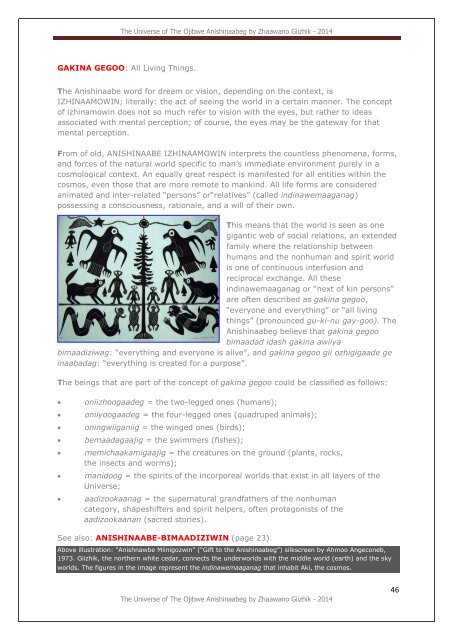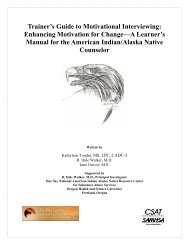An illustrated glossary by Zhaawano Giizhik*
You also want an ePaper? Increase the reach of your titles
YUMPU automatically turns print PDFs into web optimized ePapers that Google loves.
The Universe of The Ojibwe <strong>An</strong>ishinaabeg <strong>by</strong> <strong>Zhaawano</strong> Giizhik - 2014<br />
GAKINA GEGOO: All Living Things.<br />
The <strong>An</strong>ishinaabe word for dream or vision, depending on the context, is<br />
IZHINAAMOWIN; literally: the act of seeing the world in a certain manner. The concept<br />
of izhinamowin does not so much refer to vision with the eyes, but rather to ideas<br />
associated with mental perception; of course, the eyes may be the gateway for that<br />
mental perception.<br />
From of old, ANISHINAABE IZHINAAMOWIN interprets the countless phenomena, forms,<br />
and forces of the natural world specific to man’s immediate environment purely in a<br />
cosmological context. <strong>An</strong> equally great respect is manifested for all entities within the<br />
cosmos, even those that are more remote to mankind. All life forms are considered<br />
animated and inter-related “persons” or“relatives” (called indinawemaaganag)<br />
possessing a consciousness, rationale, and a will of their own.<br />
This means that the world is seen as one<br />
gigantic web of social relations, an extended<br />
family where the relationship between<br />
humans and the nonhuman and spirit world<br />
is one of continuous interfusion and<br />
reciprocal exchange. All these<br />
indinawemaaganag or “next of kin persons”<br />
are often described as gakina gegoo,<br />
“everyone and everything” or “all living<br />
things” (pronounced gu-ki-nu gay-goo). The<br />
<strong>An</strong>ishinaabeg believe that gakina gegoo<br />
bimaadad idash gakina awiiya<br />
bimaadiziwag: “everything and everyone is alive”, and gakina gegoo gii ozhigigaade ge<br />
inaabadag: “everything is created for a purpose”.<br />
The beings that are part of the concept of gakina gegoo could be classified as follows:<br />
<br />
<br />
<br />
<br />
<br />
<br />
<br />
oniizhoogaadeg = the two-legged ones (humans);<br />
oniiyoogaadeg = the four-legged ones (quadruped animals);<br />
oningwiiganiig = the winged ones (birds);<br />
bemaadagaajig = the swimmers (fishes);<br />
memichaakamigaajig = the creatures on the ground (plants, rocks,<br />
the insects and worms);<br />
manidoog = the spirits of the incorporeal worlds that exist in all layers of the<br />
Universe;<br />
aadizookaanag = the supernatural grandfathers of the nonhuman<br />
category, shapeshifters and spirit helpers, often protagonists of the<br />
aadizookaanan (sacred stories).<br />
See also: ANISHINAABE-BIMAADIZIWIN (page 23).<br />
Above illustration: “<strong>An</strong>ishnawbe Miinigozwin” (“Gift to the <strong>An</strong>ishinaabeg”) silkscreen <strong>by</strong> Ahmoo <strong>An</strong>geconeb,<br />
1973. Giizhik, the northern white cedar, connects the underworlds with the middle world (earth) and the sky<br />
worlds. The figures in the image represent the indinawemaaganag that inhabit Aki, the cosmos.<br />
The Universe of The Ojibwe <strong>An</strong>ishinaabeg <strong>by</strong> <strong>Zhaawano</strong> Giizhik - 2014<br />
46




